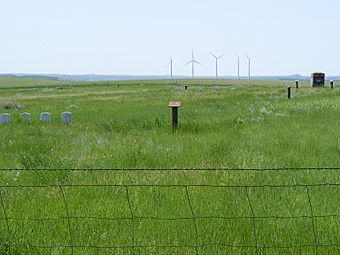Fort Dilts facts for kids
Quick facts for kids |
|
|
Fort Dilts
|
|
 |
|
| Nearest city | Rhame, North Dakota |
|---|---|
| Area | 8.3 acres (3.4 ha) |
| Built | 1864 |
| NRHP reference No. | 80002907 |
| Added to NRHP | November 10, 1980 |
Fort Dilts was a temporary fort built from sod (chunks of earth with grass) in September 1864. It was located near Rhame, North Dakota. This fort was quickly put together to protect a group of gold-miners and their small military escort. They were surrounded by Hunkpapa Sioux warriors, led by the famous chief Sitting Bull.
Contents
The Journey to Fort Dilts
In 1864, during the American Civil War, a group of people set out from Fort Ridgely, Minnesota. They hoped to find gold. Captain James L. Fisk of the U.S. Army led this wagon train. The Dakota Territory did not have many soldiers at this time.
Facing Challenges on the Trail
On September 2, 1864, Sitting Bull and his Hunkpapa Sioux warriors attacked the group. The wagon train was still being bothered by the Sioux two days later. They needed a safe place to defend themselves.
Building a Sod Fort
The travelers found a good spot to build a defense. They quickly built a circular wall using sod. This wall was about 6.5 feet (2.0 m) high and 300 feet (91 m) across. They called their new fort "Fort Dilts."
Honoring a Fallen Soldier
The fort was named after Corporal Jefferson Dilts. He was one of eight U.S. Army soldiers who died during the attacks. About 50 soldiers were with the wagon train. Some civilians also lost their lives.
Help Arrives
Lieutenant Smith and fifteen others managed to get to Fort Rice. They brought news of the trapped wagon train. Reinforcements arrived to help the people at Fort Dilts on September 20.
Fort Dilts Today
Today, Fort Dilts is a special place. It has been a North Dakota historic site since 1932. In 1980, it was added to the National Register of Historic Places. This means it is recognized as an important historical location.
What You Can See at the Site
The historic site covers about 8.3 acres (3.4 ha). You can still see the old sod enclosure where the fort stood. There are also wagon ruts, which are marks left by the wagons. You might also find some grave markers and a sign that tells the story of the fort.



